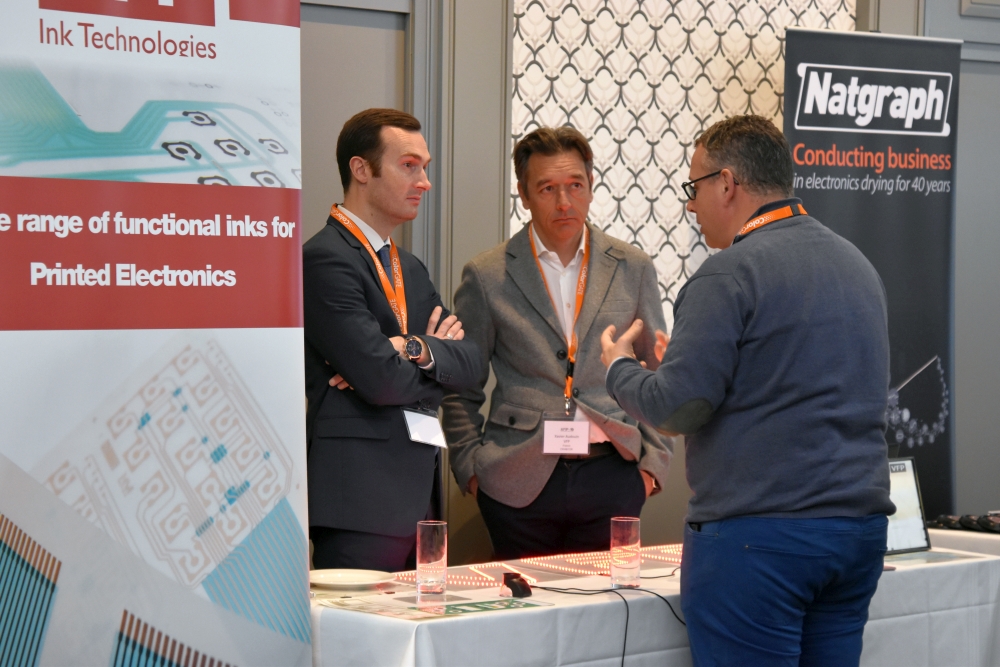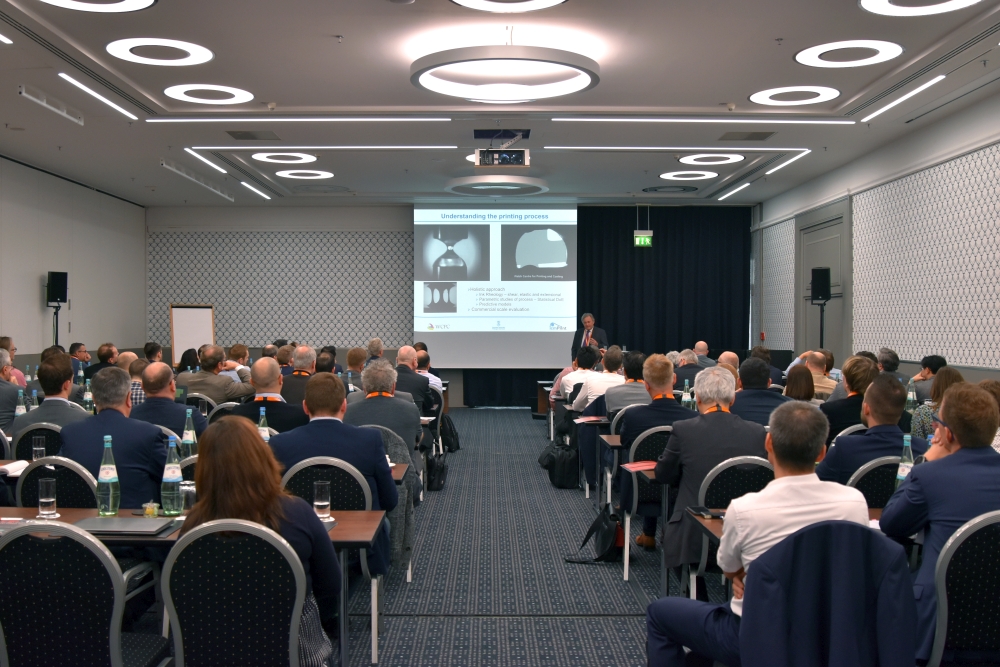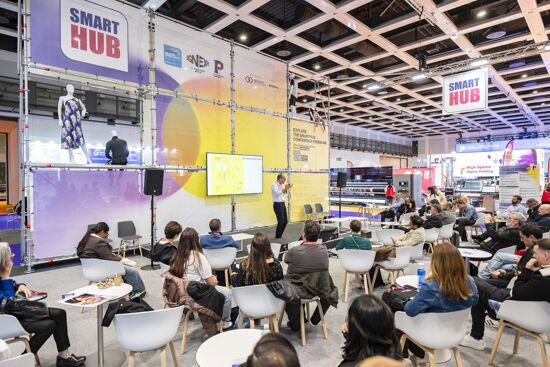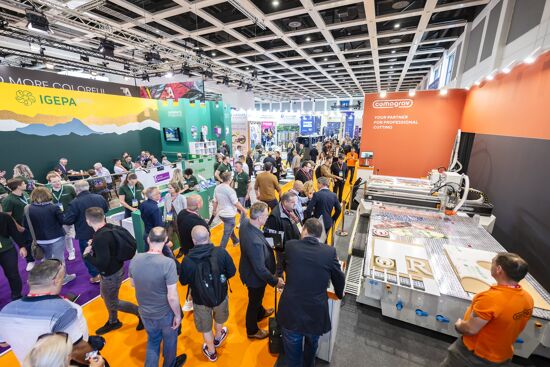Advanced Functional and Industrial Printing Conference 2019 part 2

Graeme Richardson-Locke continues in part 2 of his blog to describe his experience at ESMA’s AFIP 2019 conference in Dusseldorf.
During the networking sessions I visited each of the CTS manufacturers stands and was impressed by the resolution available which was clearly an improvement over all film systems.
Yoshinori Domae from Seiko addressed the topic of how to make printhead jetting more adaptable to a wider range of viscosities and particle sizes. He demonstrated examples from Nozomi and Barberan single pass presses and ceramic inkjet printing technology that emphasizes that imaging is just a component of a wider industrial production process. Yoshinori’s view is that ceramic inkjet has been very successful due to the drop on demand variable droplet size and non-contact application qualities. The latest Seiko RC1536-L at 400 dpi offers very high levels of productivity, however the print head has a broad configuration capacity to run from 8-22 c poise with particles up to 3,000 nm. It features a broad jetting temperature range, a print throw of up to 20mm and a speed of up to 90 m/min with a droplet up to 230pl at 180 dpi, a whole new range of industrial uses are opening up. The key point is that head technologies are advancing in their scope to print a much wider variety of fluids.
 Patrick Brunner of Sefar, presented on the important role of precision mesh in industrial printing applications. Brunner explained that the best filament for high tension low elongation performance is used in PET 1500 polyester mesh with its range from 8-190 thread/cm. It is the most popular product line but where dimensional accuracy is critical, PME mesh is the highest performing product. This is used for printing touch screen, display, thick film, in mould electronics. Patrick also explained the advantages of Sefar PCF pre-coated fabric where the 180-27Y with 3µm EOM (emulsion over mesh) gives higher resolution, sharper prints and leaner production workflow. Finally, he mentioned Glassline mesh that has very precise weave geometry which is important when stretching very large screens for the flat glass industry, whether architectural or automotive.
Patrick Brunner of Sefar, presented on the important role of precision mesh in industrial printing applications. Brunner explained that the best filament for high tension low elongation performance is used in PET 1500 polyester mesh with its range from 8-190 thread/cm. It is the most popular product line but where dimensional accuracy is critical, PME mesh is the highest performing product. This is used for printing touch screen, display, thick film, in mould electronics. Patrick also explained the advantages of Sefar PCF pre-coated fabric where the 180-27Y with 3µm EOM (emulsion over mesh) gives higher resolution, sharper prints and leaner production workflow. Finally, he mentioned Glassline mesh that has very precise weave geometry which is important when stretching very large screens for the flat glass industry, whether architectural or automotive.
 Peter Fleischer of PVF also discusses the manufacturing of stainless-steel mesh. NBC from Japan have developed a range of mesh grades that use purer stainless steel by re-melting it three times to remove impurities before weaving. They also have a mesh from tungsten which is capable of increased dimensional stability and thinner diameter filaments down to 13µm. The tungsten has a rough surface with an open area of 61%, trials have achieved line widths at 20µm. He claimed that silver nano paste inks have been printed down to line widths of 10µm.
Peter Fleischer of PVF also discusses the manufacturing of stainless-steel mesh. NBC from Japan have developed a range of mesh grades that use purer stainless steel by re-melting it three times to remove impurities before weaving. They also have a mesh from tungsten which is capable of increased dimensional stability and thinner diameter filaments down to 13µm. The tungsten has a rough surface with an open area of 61%, trials have achieved line widths at 20µm. He claimed that silver nano paste inks have been printed down to line widths of 10µm.
NBC also weave their V-Screen which is a polymer super fibre mesh suitable for when large format electronics are printed up to 155cm wide as stainless steel or tungsten meshes stop at 122cm wide.
A couple of presentations focused on NIR (near infra-red) curing. Firstly, Dr. Kai Bar of Adphos spoke about NIR curing of coatings with lower energy and temperature than IR. The technology will allow water-based inks to cure very fast when exposed to near IR and air knives moving 1000 cubic metres per minute. It has the advantage of a small footprint and prevents cockling as the drying phase is so fast. You can personalise chocolate bar wrappers and cure the ink without melting the chocolate inside. If you require low temperature curing the solution is at 60-70 degrees Celsius with very short exposure time. Ralf Martin Eckert from Lambda technology presented about their NIR drying solutions, sitting within 700-800nm wavelength range. Their solutions offer the same very fast curing energy which is ready for production with a warm up of just two seconds.
Amongst the list of ink manufacturers represented, Claudia Bauer from Marabu discussed haptic (texture) special effect inks screen printed on aluminium trim in automotive applications. These techniques require high levels of resistance to chemicals and abrasion. Ink makers depend on a wide range of ink chemistries, ensuring that these inks are silicone free to ensure total optical clarity.
The German industrial ink maker, Proell asked Dr. Hans-Peter Erfurt to present on developments in IMD/FIM screen printing inks, adhesion promoters and lacquers. As Head of R&D he discussed Noriphan and Norilux DC ink systems for in mould design. Top coats are now printed to resist products like sun cream in automotive use which are very aggressive. During the breakout sessions I carefully examined their samples that will be appearing in the cars we own in the near future. These featured capacitive touch controls that are integrated into dashboard and console controls. He talked about Spinel black which is a recent development that isn’t conductive, so it is suitable for decorative use where capacitive touch is required. The use of CMYK inks sub-surface printed on clear UV resistant film finished with UV filtering clear lacquers facilitates photographic imaging and Enables new and novel backlit effects.
Germano Primi of EPTANOVA presented his paper on advanced finishing solutions. The business includes Manoukian, TW Graphics and Verojet. Germano explained, that they offer coatings for decorative and aesthetic applications to add hygiene and anti-corrosion performance. They’re also formulating invisible screen inks for security applications in fashion. The range of capabilities of this process continue to grow where performance chemistry can be deposited through a screen.
Dr. Srdan Vasic from Extensis group is an inventor of 3D screen printed technology, working with metal, ceramic and polymers to commercialise high volume industrial production where additive components are sintered after printing finishing them into homogenous parts.
Jerome Mouly of Yole Developments presented on inkjet printing developments in electronic and Bio-printing markets. The consulting group offers a broad-based range of services around research, cost analysis and IP clearing.
There are undeniable advantages of using inkjet technology in low to medium volume production, as the tooling free approach offers lean manufacturing. Of course, selecting print heads that can deposit the required particle size in functional applications is challenging, as are viscosity limits. Recirculation print heads from Ricoh and Xaar are presenting a new way forward. Merck are working with Epson to create printable OLED materials and Dupont on nano-conductive inks.
Printer makers like Pixdro JETx from Meyer Berger, nJet solder mask, Tokyo Electron, Unijet, M-Solv, Kateeva, Novacentrix, Nanodimension, Orbotech are all busy creating inkjet printing systems for electronics and industrial coating markets.
The market forecast that there will be a growth CAGR of +26.8% over the next five years in inkjet printers for industrial use which will lead to a market worth $1.2 Billion in functional electronics printing. The current challenges for OLED are currently focused on TV, as smaller devices require higher levels of resolution than are currently achievable. Screen printing is likely to remain the primary process for PCB’s with a market size of $62 billion. Inkjet is improving but doesn’t look to threaten established methods in the short term.
Digital Fabrication of Flexible Electronics was introduced by Fernado Cortes Salazar of AGFA. With a global staff of 6,000 employees and sales of 2.4 Billion euros AGFA has the size to investigate and innovate in inkjet printed electronics. They are focusing on silver conductives and dielectrics. Their results have shown that lower resistance is achievable from inkjet from <200 to <53 mΩ/□.
By working with MGI Ceradrop AGFA have succeeded using paper-based circuits using NIR drying. The ink has been tested for printing and has not suffered from jetting issues even when the printer wasn’t run for two weeks. In addition, Salazar stated that the shelf life for silver conductive is 12 months. They have proof of concept and are now working to build the ecosystem that allows the full commercialisation of inkjet in printed electronics.
Next up was the topic, ‘From 2D to 3D printed electronics. This was introduced by Dr. Claudia Delgado Simao from Eurecat, the technology centre of Catalunya. They work across aerospace, wearable and automotive innovations. Claudia shared numerous projects, from thermoformed printed electronics aimed at automotive clients to an NFC sensor that could provide information about the quality of wine using smart label which has a built-in spectrophotometer to measure the changes in colour of the wine. Using Silicone and latex-based substrates, the centre have developed stretchable electronics for wearable electronics for health and fitness applications. This work indicates that we will be seeing a wider range of products will be launched within the internet of things.
The second to last speaker on day two was Matthew Pullen of Meteor Inkjet. He presented on waveform development to control the ink release from piezo inkjet nozzles. Meteor have 40 members of staff based in Cambridge with offices in US, China and Japan. They develop the control software to drive inkjet head technologies and are part of Global Graphics. In electronics where the ink is conductive, a method must be developed to keep the ink separate from the PZT as it creates short circuits preventing the nozzle from firing. MEMS techniques such as those used in single pass or continuous inkjet are grown on silicon wafers, which is very small to my understanding.
The last presentation of the day was a very intense conference lead by Dr. Paul Jahnke of Phantomx. Jahnke works in the 3D printing of ‘phantoms’ for radiology research and training. High dose radiation is used to destroy cancer cells and tumours, low doses are used in imaging. Jahnke and his team faced the challenge of creating models that behave like human bodies when using x-rays. They captured greyscale images obtained through CT radiology to provide insight into system performance and training for radiologists.
Anthropomorphic Phantoms have been available for some time although they lack the detail required to meet performance demands. The project has developed to a point now where they are printing cellulose paper with inks that mimic the chemical properties of human tissue. This application is now used to calibrate systems and train radiologists in setting the appropriate dose of radiation for achieving the best diagnostic tools.
I hope this has been an interesting read, it is challenging to report back following exposure to so many talented people. I have been genuinely inspired and the one thing we all know for sure is that tomorrow’s world is being crafted today and hopefully we will see the amazing changes that will follow.
Topics
Interested in joining our community?
Enquire today about joining your local FESPA Association or FESPA Direct
Recent news

Industry Experts Explore the Evolution of Smart Manufacturing in the Textile Industry
A FESPA SmartHUB roundtable at Personalisation Experience 2025 discussed smart manufacturing's transformative impact on the textile industry. Experts highlighted the shift to on-demand customisation, driven by digital printing, data analytics, and automation. Key takeaways included enhanced machine control, significant waste reduction through intelligent software and colour management, and improved sustainability via energy efficiency and near-shoring, ensuring agility and environmental responsibility in textile production.

FESPA 2025 gathers leading visionaries from across the speciality print industry in Berlin
FESPA Global Print Expo 2025, European Sign Expo and Personalisation Experience (6 – 9 May 2025, Messe Berlin, Germany) welcomed Visionaries from across the speciality print industry to shape the future of print, develop forward-thinking business strategies, and explore innovative ways to translate emerging industry trends into tangible growth opportunities.

Exploring Cutting-Edge Textile Printing Innovation with Adobe Print Engine 7
Adobe PDF Print Engine 7, launched at FESPA Global Print 2025, significantly advances textile printing. Debbie McKeegan shares how it automates non-white substrate management and RGB colour handling, expands colour gamuts with in-RIP multicolour transparency blending, and streamlines workflows for efficiency and sustainability. This update boosts customisation, reduces waste, and positions businesses at the forefront of digital print innovation.

FESPA Global Print Expo 2025 - Overall Highlights
FESPA Global Print Expo, Europe's leading print and signage exhibition returned to Messe Berlin from 6 - 9 May 2025.